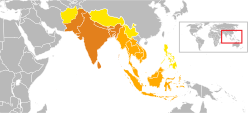ग्रेटर इंडिया
भारत के सांस्कृतिक प्रभाव वाला क्षेत्र
ग्रेटर इंडिया चाहे इंडोस्फियर भारत के सांस्कृतिक परभाव वाला क्षेत्र हवे।
संदर्भ
संपादन करीं- ↑ Patel, Sneha (2015). "India's South Asian Policy". The Indian Journal of Political Science. 76 (3): 677–680. JSTOR 26534911.
It is important to note that Nepal was not a British colony like India. Geographically, culturally, socially and historically India and Nepal are linked most intimately and lived together from time immemorial. The most significant factor which has nurtured Indo-Nepalese relations through ages is geographical setting of the two countries which is a good example to understand that how geography connects the two countries
- ↑ Mehta, Jaswant Lal (1979). Advanced Study in the History of Medieval India (अंग्रेजी में). Vol. I (1st ed.). Sterling Publishers. p. 31. OCLC 557595150.
Modern Afghanistan was part of ancient India; the Afghans belonged to the pale of Indo-Aryan civilisation. In the eighty century, the country was known by two regional names—Kabul land Zabul. The northern part, called Kabul (or Kabulistan) was governed by a Buddhist dynasty. Its capital and the river on the banks of which it was situated, also bore the same name. Lalliya, a Brahmin minister of the last Buddhist ruler Lagaturman, deposed his master and laid the foundation of the Hindushahi dynasty in c. 865.
- ↑ Chandra, Satish (2006). Medieval India: From Sultanat to the Mughals. Har-Anand Publications. p. 41. ISBN 9788124110669.
Although Afghanistan was considered an integral part of India in antiquity, and was often called "Little India" even in medieval times, politically it had not been a part of India after the downfall of the Kushan empire, followed by the defeat of the Hindu Shahis by Mahmud Ghazni.
| ई एशिया-संबंधी लेख एगो आधार बाटे। जानकारी जोड़ के एकरा के बढ़ावे में विकिपीडिया के मदद करीं। |
